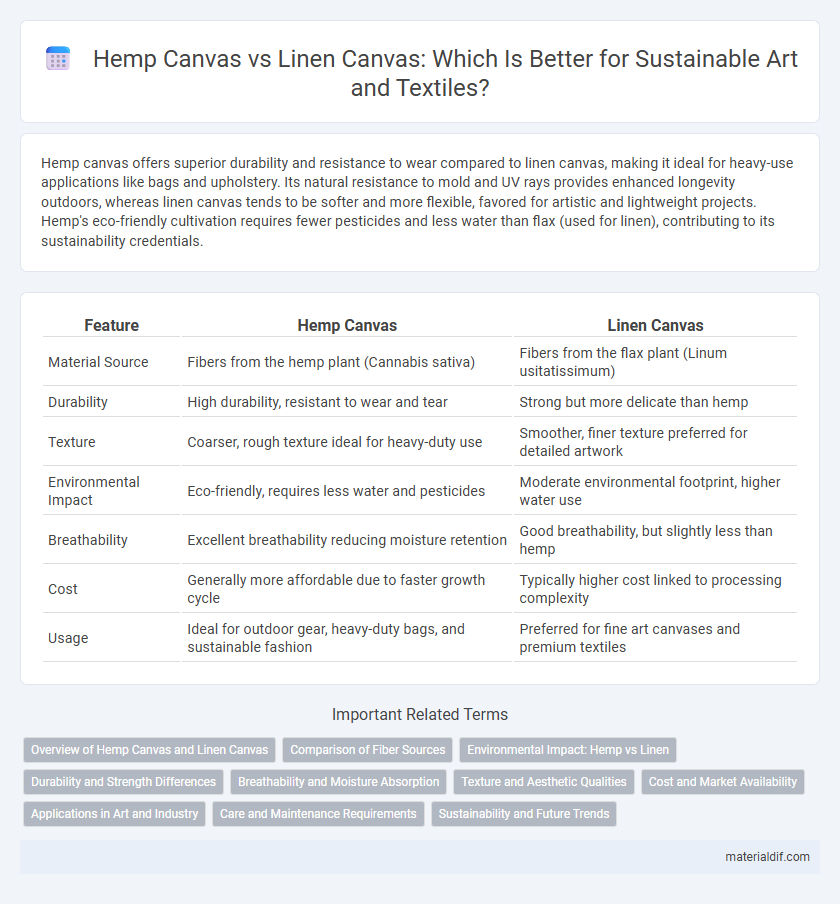Hemp canvas offers superior durability and resistance to wear compared to linen canvas, making it ideal for heavy-use applications like bags and upholstery. Its natural resistance to mold and UV rays provides enhanced longevity outdoors, whereas linen canvas tends to be softer and more flexible, favored for artistic and lightweight projects. Hemp's eco-friendly cultivation requires fewer pesticides and less water than flax (used for linen), contributing to its sustainability credentials.
Table of Comparison
| Feature | Hemp Canvas | Linen Canvas |
|---|---|---|
| Material Source | Fibers from the hemp plant (Cannabis sativa) | Fibers from the flax plant (Linum usitatissimum) |
| Durability | High durability, resistant to wear and tear | Strong but more delicate than hemp |
| Texture | Coarser, rough texture ideal for heavy-duty use | Smoother, finer texture preferred for detailed artwork |
| Environmental Impact | Eco-friendly, requires less water and pesticides | Moderate environmental footprint, higher water use |
| Breathability | Excellent breathability reducing moisture retention | Good breathability, but slightly less than hemp |
| Cost | Generally more affordable due to faster growth cycle | Typically higher cost linked to processing complexity |
| Usage | Ideal for outdoor gear, heavy-duty bags, and sustainable fashion | Preferred for fine art canvases and premium textiles |
Overview of Hemp Canvas and Linen Canvas
Hemp canvas offers superior durability and resistance to wear compared to linen canvas, making it ideal for heavy-duty applications like bags and upholstery. Linen canvas, derived from flax fibers, provides a smoother texture and is prized for its natural luster and breathability in art and fashion industries. Both fabrics are eco-friendly; however, hemp's faster growth cycle and higher fiber yield make it a more sustainable choice for canvas production.
Comparison of Fiber Sources
Hemp canvas is derived from the stalks of the Cannabis sativa plant, known for its strong, coarse fibers, while linen canvas is made from the flax plant's fibers, which are finer and smoother. Hemp fibers tend to be more durable and resistant to mold and UV damage compared to linen, which offers a softer texture but is less robust. Both materials are sustainable, but hemp cultivation typically requires less water and fewer pesticides, enhancing its environmental advantages over flax used for linen.
Environmental Impact: Hemp vs Linen
Hemp canvas has a significantly lower environmental impact compared to linen canvas due to its rapid growth cycle, requiring less water and fewer pesticides. Hemp cultivation results in higher carbon sequestration and improves soil health, whereas flax used for linen demands more intensive agricultural inputs. The durability and biodegradability of hemp fabric also contribute to its superior sustainability profile.
Durability and Strength Differences
Hemp canvas outperforms linen canvas in durability and strength due to its long, strong fibers that resist wear and tear more effectively. Hemp fibers exhibit superior tensile strength, making hemp canvas less prone to stretching, shrinking, and tearing compared to linen. This enhanced robustness positions hemp canvas as an ideal choice for heavy-duty applications requiring long-lasting fabric performance.
Breathability and Moisture Absorption
Hemp canvas offers superior breathability compared to linen canvas due to its coarser fibers, allowing better air circulation and faster drying times. Its natural moisture absorption capabilities help prevent mold and mildew, making it ideal for outdoor and high-humidity environments. While linen canvas also absorbs moisture well, hemp's durability and resilience enhance its performance in maintaining a dry, breathable surface.
Texture and Aesthetic Qualities
Hemp canvas features a coarser, more textured surface with a natural, rustic appeal, making it ideal for projects requiring durability and an organic look. Linen canvas offers a finer, smoother texture with a subtle sheen, providing a classic and refined aesthetic preferred in high-quality art and fashion applications. Both materials exhibit unique tactile qualities, with hemp emphasizing ruggedness and linen highlighting elegance.
Cost and Market Availability
Hemp canvas generally offers a more cost-effective option compared to linen canvas due to the faster growth cycle and higher yield of hemp plants. Market availability of hemp canvas is expanding rapidly as sustainable fashion and eco-friendly materials gain popularity, whereas linen canvas remains more traditional but often pricier and less widely sourced. Both fibers present durable choices, but hemp's affordability and increasing accessibility make it a preferred option for budget-conscious consumers and manufacturers.
Applications in Art and Industry
Hemp canvas offers superior durability and resistance to wear, making it ideal for heavy-duty applications in both art and industrial sectors, including painting and upholstery. Linen canvas, prized for its fine texture and smooth surface, is preferred by artists for detailed oil paintings and delicate textile projects. Both materials perform well, but hemp's sustainability and strength give it an edge in eco-friendly packaging and rugged artistic creations.
Care and Maintenance Requirements
Hemp canvas is renowned for its durability and resistance to mold and UV damage, requiring minimal maintenance such as occasional brushing and air drying to preserve its strength and texture. Linen canvas, while also durable, demands more careful handling to prevent fiber weakening, often needing gentle cleaning with mild soap and avoiding prolonged exposure to moisture. Both materials benefit from regular inspections to address potential mildew, but hemp's natural resilience makes it a superior choice for low-maintenance applications.
Sustainability and Future Trends
Hemp canvas offers superior sustainability compared to linen canvas due to its rapid growth cycle, requiring less water and pesticides, which reduces environmental impact. The durability and biodegradability of hemp fibers position it as a leading choice for sustainable textiles in future eco-conscious markets. Innovations in hemp processing technologies are accelerating its adoption, making hemp canvas a key material in the shift toward greener, more sustainable fabric solutions.
hemp canvas vs linen canvas Infographic

 materialdif.com
materialdif.com